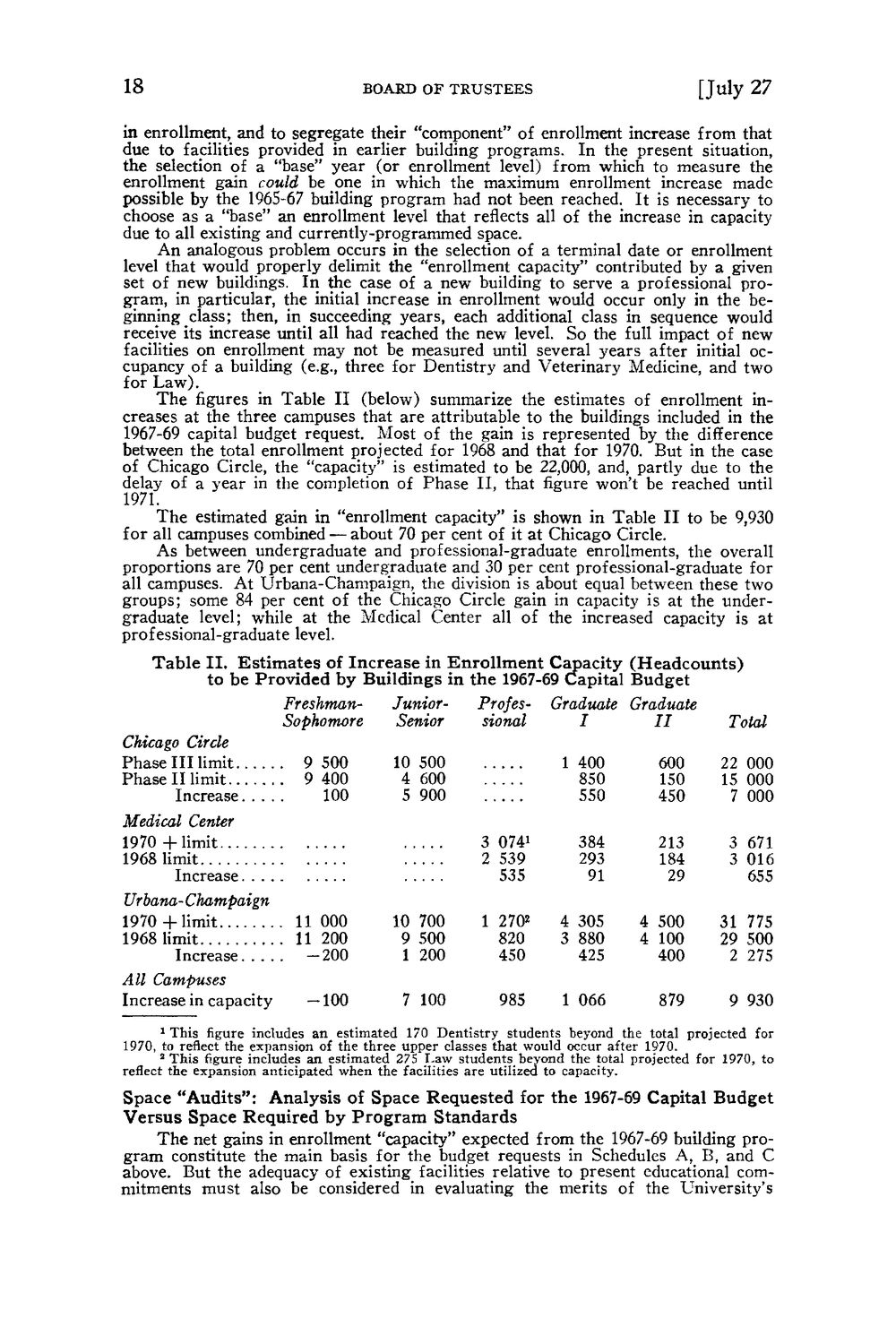| |
| |
Caption: Board of Trustees Minutes - 1968
This is a reduced-resolution page image for fast online browsing.

EXTRACTED TEXT FROM PAGE:
18 BOARD OF T R U S T E E S [July 27 in enrollment, and to segregate their "component" of enrollment increase from that due to facilities provided in earlier building programs. In the present situation, the selection of a "base" year (or enrollment level) from which to measure the enrollment gain could be one in which the maximum enrollment increase made possible by the 1965-67 building program had not been reached. It is necessary to choose as a "base" an enrollment level that reflects all of the increase in capacity due to all existing and currently-programmed space. An analogous problem occurs in the selection of a terminal date or enrollment level that would properly delimit the "enrollment capacity" contributed by a given set of new buildings. In the case of a new building to serve a professional program, in particular, the initial increase in enrollment would occur only in the beginning class; then, in succeeding years, each additional class in sequence would receive its increase until all had reached the new level. So the full impact of new facilities on enrollment may not be measured until several years after initial occupancy of a building (e.g., three for Dentistry and Veterinary Medicine, and two for Law). T h e figures in Table II (below) summarize the estimates of enrollment increases at the three campuses that are attributable to the buildings included in the 1967-69 capital budget request. Most of the gain is represented by the difference between the total enrollment projected for 1968 and that for 1970. But in the case of Chicago Circle, the "capacity" is estimated to be 22,000, and, partly due to the delay of a year in the completion of Phase II, that figure won't be reached until 1971. T h e estimated gain in "enrollment capacity" is shown in Table I I to be 9,930 for all campuses combined — about 70 per cent of it at Chicago Circle. As between undergraduate and professional-graduate enrollments, the overall proportions are 70 per cent undergraduate and 30 per cent professional-graduate for all campuses. At Urbana-Champaign, the division is about equal between these two groups; some 84 per cent of the Chicago Circle gain in capacity is at the undergraduate level; while at the Medical Center all of the increased capacity is at professional-graduate level. Table II. Estimates of Increase in Enrollment Capacity (Headcounts) to be Provided by Buildings in the 1967-69 Capital Budget FreshmanJuniorProfes- Graduate Graduate Sophomore Senior J sional II Total Chicago Circle 10 500 1 400 Phase III limit 9 500 600 22 000 9 400 4 600 850 150 IS 000 Phase II limit 100 5 900 550 450 7 000 Increase. . . . Medical Center 3 074 1 384 1970 + limit 213 3 671 293 2 539 184 3 016 1968 limit 91 535 29 Increase.. . . 655 Urbana- Champaign 11 000 1 2702 4 305 1970+limit 10 700 4 500 31 775 9 500 820 11 200 3 880 4 100 29 500 1968 limit 1 200 450 Increase. . . . . -200 425 400 2 275 All Campuses 1 066 Increase in capacity -100 7 100 985 879 9 930 1 This figure includes an estimated 170 Dentistry students beyond the total projected for 1970, 2to reflect the expansion of the three tipper classes that would occur after 1970. This figure includes an estimated 275 Law students beyond the total projected for 1970, to reflect the expansion anticipated when the facilities are utilized to capacity. Space "Audits": Analysis of Space Requested for the 1967-69 Capital Budget Versus Space Required by Program Standards T h e net gains in enrollment "capacity" expected from the 1967-69 building program constitute the main basis for the budget requests in Schedules A, B, and C above. But the adequacy of existing facilities relative to present educational commitments must also be considered in evaluating the merits of the University's
| |